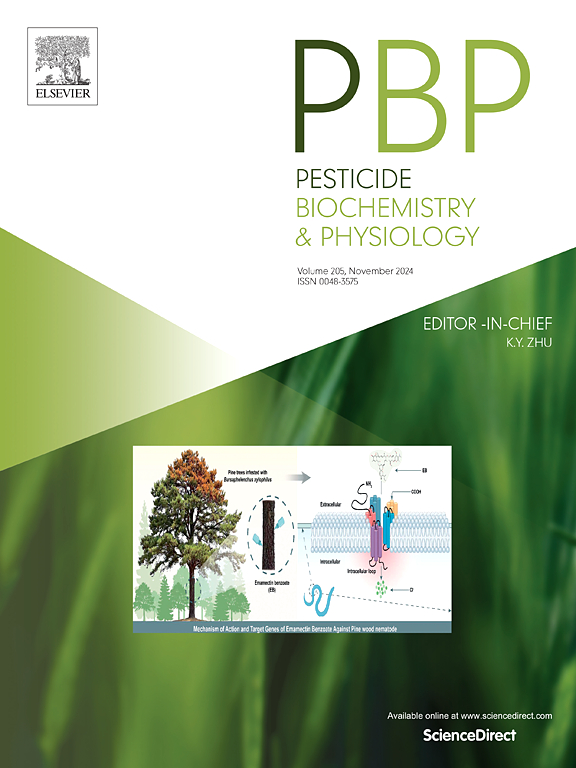Functional characterization of chemosensory proteins in three sympatric Tomicus bark beetles feeding on Pinus yunnanensis: Implication for the conservation and divergence of ligand-binding profiles
IF 4.2
1区 农林科学
Q2 BIOCHEMISTRY & MOLECULAR BIOLOGY
引用次数: 0
Abstract
Three sympatric Tomicus bark beetles, Tomicus yunnanensis, Tomicus brevipilosus and Tomicus minor that coexist in the trunks of a pine but occupy different spatiotemporal ecological niches, are the best-studied examples for addressing functional differentiation of chemosensory protein (CSP) orthologs. Here, totally 36 CSP-coding genes belonging to 12 groups of orthologs were identified from three Tomicus beetles. Tomicus CSP orthologs shared the high conservation and slight differences in sequence characteristics, phylogenetic relationships and tissue expression profiles. Binding assays revealed that 12 antenna-enriched Tomicus CSPs could respond strongly to non-host volatiles, pheromones and insecticides where each group of CSP orthologs presented diverse ligand-binding properties. CSP1 and CSP2 could interact strongly with benzaldehyde and salicylaldehyde (dissociation constant, Ki < 14 μM) whereas CSP10 and CSP11 preferred to bind 1-hexanol and acetophenone (Ki < 13 μM). All the proteins were tuned to chlorpyrifos with particularly high affinities (Ki < 10 μM). Two conserved residues (glutamine, Q64 and leucine, L72) of CSP11 orthologs contributed to the specific binding to optimal ligands, but exhibited opposite binding properties between chlorpyrifos and other four compounds. Our study sheds light on the functional conservation and divergence of Tomicus CSP orthologs in olfactory reception and insecticide resistance, implying the correlation between ecological niche differentiation and olfactory specialization in three Tomicus bar beetles.

以云南松为食的三种同域Tomicus树皮甲虫化学感觉蛋白的功能特征及其配体结合谱的保存和分化意义
三种同域分布的Tomicus树皮甲虫(Tomicus yunnanensis, Tomicus brevipilosus和Tomicus minor)共存于松树树干中,但占据不同的时空生态位,是研究化学感觉蛋白(CSP)同源物功能分化的最好例子。本研究共鉴定出12个直系同源群的36个csp编码基因。Tomicus CSP同源基因在序列特征、系统发育关系和组织表达谱上具有高度保守性和微小差异。结合实验表明,12个富集天线的Tomicus CSP对非寄主挥发物、信息素和杀虫剂有较强的反应,且每组CSP同源物具有不同的配体结合特性。CSP1和CSP2能与苯甲醛和水杨醛(解离常数Ki <;14 μM),而CSP10和CSP11倾向于结合1-己醇和苯乙酮(Ki <;13μM)。所有的蛋白都与毒死蜱具有特别高的亲和力(Ki <;10μM)。CSP11同源物的两个保守残基(谷氨酰胺Q64和亮氨酸L72)有助于与最佳配体的特异性结合,但毒死蜱与其他4种化合物的结合特性相反。本研究揭示了三种斑蝽CSP同源物在嗅觉接收和杀虫剂抗性方面的功能保护和分化,暗示了生态位分化与嗅觉专门化之间的相关性。
本文章由计算机程序翻译,如有差异,请以英文原文为准。
求助全文
约1分钟内获得全文
求助全文
来源期刊
CiteScore
7.00
自引率
8.50%
发文量
238
审稿时长
4.2 months
期刊介绍:
Pesticide Biochemistry and Physiology publishes original scientific articles pertaining to the mode of action of plant protection agents such as insecticides, fungicides, herbicides, and similar compounds, including nonlethal pest control agents, biosynthesis of pheromones, hormones, and plant resistance agents. Manuscripts may include a biochemical, physiological, or molecular study for an understanding of comparative toxicology or selective toxicity of both target and nontarget organisms. Particular interest will be given to studies on the molecular biology of pest control, toxicology, and pesticide resistance.
Research Areas Emphasized Include the Biochemistry and Physiology of:
• Comparative toxicity
• Mode of action
• Pathophysiology
• Plant growth regulators
• Resistance
• Other effects of pesticides on both parasites and hosts.

 求助内容:
求助内容: 应助结果提醒方式:
应助结果提醒方式:


